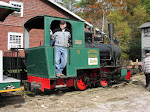Saturday, February 7, 2015
A day in the life of a Lokführer on E10 306, 1962
A day in the life of a Lokführer on E10 306. Back then E10 306 would looked like this. Image from Drehscheibe Online. Video in German.
Saturday, December 6, 2014
Card Models in Video Games
Wow! Love the fact that they made real models rather than using CGI for all. Images look like they could be sets for the Cabinet of Dr. Caligari.
Saturday, November 29, 2014
Tuesday, October 21, 2014
We Build From Cardboard
Haven't spent any time on the layout in ages, came out of a malaise and headed into over-commitmentland, but need to get back to it. Biggest reason is fixing some water damage from a flood that came from above. Nothing too serious, but the abbey on the hill is gone (I have a small castle ready) and some trees to fix along with some other things.
I have similar book of what we now call "DIY" projects, things like building radio controlled ships, models of structures for train layouts, art projects. many of them used card - an inexpensive, readily available material that is easy to work with. My book is less political and published in the late 60s in Germany. Still, should dig it out. Easy to find though, and with my MRR books.
Full post with more pictures on the The Charnel-House - From Bauhaus to Beinhaus blog.
Then for that post-communist look there is EASTERN BLOCK by Zupagrafika.
Good article with more images on the Packaging of the World blog.
From the same company in Poland... BLOKOGRAFIA, a Modernist Alphabet by Zupagrafika
More pictures at Packaging of the World and here.
One of the lofty goals of Communist Party and education officials was to create “harmonious human beings” by instilling Soviet morals and work habits into the minds of young children. While literacy rates in the first decade after the October Revolution were remarkably low, reading was soon to become the single most important way of socializing and educating children in the Soviet Union. An important but lesser-known aspect of Soviet 1930s education involved do-it-yourself books. These were conceived as an interactive medium that invited children not only to enjoy reading, absorb information and reflect, but also to develop practical skills needed for the construction of a Communist society.
I have similar book of what we now call "DIY" projects, things like building radio controlled ships, models of structures for train layouts, art projects. many of them used card - an inexpensive, readily available material that is easy to work with. My book is less political and published in the late 60s in Germany. Still, should dig it out. Easy to find though, and with my MRR books.
Full post with more pictures on the The Charnel-House - From Bauhaus to Beinhaus blog.
Then for that post-communist look there is EASTERN BLOCK by Zupagrafika.
Blok Wschodni / Eastern Block is a collection of paper cut-out models representing various modernist buildings in Warsaw, Poland.
The series, created and distributed by the polish graphic design studio Zupagrafika, is made up of iconic examples of modernist architecture (Rotunda PKO), some less classic buildings, however, familiar to the city dwellers (Za Żelazną Bramą, Smolna 8, Mokotów), as well as "Wielka Płyta" prefab blocks from the outskirts (Tarchomin).
The whole set is eco-friendly as it is made from 100% recycled paper and carton. Each building is hand-drawn and includes a short technical note on its architects, year of construction and exact location.
The complete collection can be ordered online from Zupagrafika´s website and bought in bookshops and concept stores around Poland and Germany.
Good article with more images on the Packaging of the World blog.
From the same company in Poland... BLOKOGRAFIA, a Modernist Alphabet by Zupagrafika
Blokografia is a collection of paper cut-out typographies designed by polish studio Zupagrafika and inspired by Polish modernist architecture: from the prefab blocks in the districts to the ones in the city centers.
The collection consists of several buildings in different Polish cities, like Poznan (Os. Orła Białego, Dom Towarowy Alfa, Budynek Telewizory, Hotel Polonez, Collegium Novum...) and Warsaw (Ża Żelazną Bramą, Smolna 8...).
The whole set is eco-friendly as it is made from 100% recycled paper and cardboard.
Each building is hand-drawn and includes a short technical note on its architects, year of construction and exact location.
The complete collection can be ordered online from Zupagrafika´s online shop and bought in bookshops and concept stores around Poland.
More pictures at Packaging of the World and here.
Subscribe to:
Posts (Atom)




.jpg)

